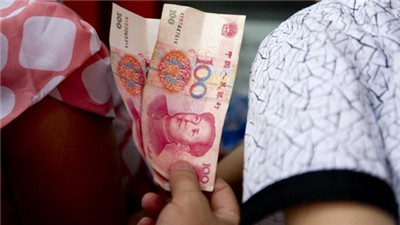China has sharply weakened the renminbi, moving the currency almost 2 per cent in a one-off move that in theory will make the tightly managed currency more responsive to market movements.
中国大幅调降了人民币汇率,通过一个一次性举措让人民币贬值了近2%。理论上说,这一举措将使受到严格管制的人民币汇率能对市场走势作出更灵敏的反应。
The central bank’s move pushed the renminbi’s “daily fix” to Rmb6.2298 against the dollar, compared with a Rmb6.1162 rate the day before. The 1.9 per cent move was its biggest one-day change in the decade since China abandoned its tight currency peg for a managed float.
中国央行此举将人民币“汇率中间价”压低至1美元兑6.2298元人民币。而此前一天的汇率中间价为1美元兑6.1162元人民币。自中国放弃人民币严格盯住美元的汇率制度、转向有管理的浮动以来,这一达1.9%的调整幅度是这十年中最大的单日调增幅度。

Before Tuesday the biggest shift this year had been a 0.16 per cent adjustment.
本周二前,今年最大的单日调整幅度也不过才0.16%。
The move comes as China battles a slowing economy and amid a push to have its currency accepted as a global reserve currency by the International Monetary Fund.
眼下,中国正在与不断放缓的经济作斗争,并在努力推动国际货币基金组织(IMF)将人民币接纳为一种“全球储备货币”。
Last week a report from the IMF highlighted operational difficulties in including the renminbi such as the divergence between onshore and offshore rates, onshore illiquidity and the mainland market’s short trading hours.
上周,IMF的一份报告重点提到了将人民币纳为“全球储备货币”的操作性困难,比如在岸与离岸人民币汇率的差异、在岸市场流动性不足、以及在岸市场每日交易时间短等问题。
On Tuesday the People’s Bank of China said the move was a one-time adjustment to reflect changes in the way it calculates the daily fix — the rate at which the central bank sets the currency every morning and from which the currency is allowed to move as much as 2 percentage points in either direction.
周二,中国央行表示,此举是一次性校正,目的是在汇率中间价的计算中反映市场的变化。人民币汇率中间价是中国央行每天上午为人民币汇率设定的点位,中国央行允许人民币汇率当天较中间价上下波动最多2%。
The PBoC said that in future the quotes reported to it by market makers should be “in conjunction with demand and supply condition in the foreign exchange market and exchange rate movement of the major currencies”.
中国央行表示,未来做市商向它提供的中间价报价应“综合考虑外汇供求情况以及国际主要货币汇率变化”。
Market observers said they expected that to leave the PBoC with a large degree of the control it had previously, while allowing it to respond to the IMF’s concerns.
市场观察人士表示,他们认为这么做会使中国央行一方面能保有此前拥有的很大一部分控制权,一方面还可对IMF的顾虑作出回应。
Both the onshore and offshore rates moved sharply in response to the PBoC’s announcement, hitting their weakest points in almost three years. Onshore renminbi, the price that trades around the fix rate, traded at Rmb6.2986 against the dollar, while the offshore rate, which can diverge from onshore but usually tracks it, reached Rmb6.3035.
中国央行的声明发布后,在岸和离岸人民币汇率都相应地大幅下跌,触及将近三年来的低点。截至本文发稿时,在岸人民币汇率(即围绕中间价交易得出的汇率)跌至1美元兑6.2986元人民币,离岸人民币汇率(可能与在岸汇率有差异,但通常会跟随在岸汇率变动)跌至1美元兑6.3035元人民币。
While currency markets were looking for the renminbi to weaken, Tuesday’s move caught traders off guard.
尽管外汇市场存在人民币贬值的预期,但中国央行周二的举措还是令交易员们措手不及。
Economists had expected China to boost its economy through other measures, such as cutting the reserves banks must keep with the central bank to boost lending.
经济学家原本预计中国会以其他手段提振经济,比如下调存款准备金率来促进放贷。
“The markets were looking for [reserve] cuts, not this revaluation/depreciation,” said Annette Beacher, chief Asia-Pacific macro strategist at TD Securities. “This was a shock to otherwise sleepy summer markets.”
道明证券(TD Securities)首席亚太宏观策略师安妮特比彻(Annette Beacher)表示:“市场预期的是降准,而不是这种升贬值。这对原本令人昏昏欲睡的夏季市场造成了很大冲击。”
The depreciation will help combat an unexpectedly large fall in China’s exports caused in part by the renminbi’s relative strength against the dollar, while rival exporters’ currencies have weakened, boosting their competitiveness.
人民币这次贬值将有助于中国应对出口的意外大幅下滑。这一下滑的部分原因是,人民币相对美元保持强势,而与中国竞争的出口国的货币却贬值了、提升了它们的竞争力。
Data this week showed exports dropped 8.3 per cent in July from the same period last year — far more than the 1.5 per cent that had been expected.
上周末的数据显示,今年7月中国出口同比下滑8.3%——远高于此前预期的1.5%。












